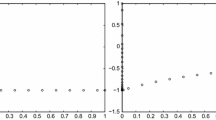Abstract
In this paper, we consider linear and time-invariant differential-algebraic equations (DAEs) Eẋ(t) = Ax(t) + f(t), x(0) = x 0, where x(·) and f(·) are functions with values in Hilbert spaces X and Z. \({E : X \to Z}\) is assumed to be a bounded operator, whereas A is closed and defined on some dense subspace D(A). A transformation to a decoupling form leads to a DAE including an abstract boundary control system. Methods of infinite-dimensional linear systems theory can then be used to formulate sufficient criteria for an initial value being consistent with the given inhomogeneity. We will further derive estimates for the trajectory x(·) in dependence of the initial state x 0 and the inhomogeneity f(·). In the theory of differential-algebraic equations, this is commonly known as perturbation analysis.
Similar content being viewed by others
References
Ball J (1977). Strongly continuous semigroups, weak solutions and the variations of constants formula. Proc Am Math Soc 63(2): 370–373
Bodestedt M, Tischendorf C (2007) PDAE models of integrated circuits and index analysis. Math Comput Model Dyn Syst 13(1):1–17
Campbell S (1980) Singular systems of differential equations. Research notes in mathematics, vol 40. Pitman Advanced Publishing Program, San Francisco, London, Melbourne
Cheng A and Morris K (2003). Well-posedness of boundary control systems. SIAM J Control Optim 42(4): 1244–1265
Chua L, Desoer C, Kuh E (1987) Linear and nonlinear circuits. Series in electrical engineering, circuits and systems. McGraw-Hill, New York
Dai L (1989) Singular control systems. Lecture notes in control and information sciences, vol 188. Springer, Berlin
Eich-Soellner E, Führer C (1998) Numerical methods in multibody dynamics. European consortium for mathematics in industry. Teubner, Stuttgart
Érdi P, Tóth J (1989) Mathematical models of chemical reactions. Theory and applications of deterministic and stochastic models. Nonlinear science: theory and applications. Manchester University Press, Manchester
Fattorini H (1968). Boundary control systems. SIAM J Control 6: 349–385
Favini A, Yagi A (1999) Degenerate differential equations in Banach spaces. No. 215 in Pure and Applied Mathematics. Marcel Dekker, New York
Günther M (2001). A PDAE model for interconnected linear RLC networks. Math Comput Model Dyn Syst 7(2): 189–203
Günther M and Wagner Y (2000). Index concepts for linear mixed systems of differential-algebraic and hyperbolic-type equations. SIAM J Sci Comput 22(5): 1610–1629
Lamour R, März R, Tischendorf C (2002) PDAEs and further mixed systems as abstract differential algebraic systems. Technical Report 01-11, Humboldt-Universität zu Berlin
Melnikova I and Al’shansky M (1997). Well-posedness of the cauchy problem in a Banach space: regular and degenerate cases. J Math Sci 87(4): 3732–3780
Pazy A (1983). Semigroups of linear operators and applications to partial differential equations. Applied mathematical sciences, vol 44. Springer, New York
Reis T (2006) Systems theoretic aspects of PDAEs and applications to electrical circuits. Doctoral dissertation, Fachbereich Mathematik, Technische Universität Kaiserslautern
Reis T and Tischendorf C (2005). Frequency domain methods and decoupling of linear infinite dimensional differential algebraic systems. J Evol Equ 5(3): 357–385
Salamon D (1987). Infinite dimensional linear systems with unbounded control and observation: a functional analytic approach. Trans Am Math Soc 300(2): 383–430
Tischendorf C (2003) Coupled systems of differential algebraic and partial differential equations in circuit and device simulation. modeling and numerical analysis. Habilitation thesis, Institut für Mathematik, Humboldt-Universität zu Berlin. Available from http://www.mathematik.hu-berlin. de/~caren/habilitation.pdf
Weiss G. (1991). Representation of shift invariant operators on L 2 by \({\mathcal{H}_\infty}\) transfer functions, an elementary proof, a generalization to L p and a counterexample for L ∞. Math Control Signals Syst 4:193–203
Weiss G (1993). Regular Linear Systems with Feedback. Math Control Signals Syst 7(1): 23–57
Author information
Authors and Affiliations
Corresponding author
Rights and permissions
About this article
Cite this article
Reis, T. Consistent initialization and perturbation analysis for abstract differential-algebraic equations. Math. Control Signals Syst. 19, 255–281 (2007). https://doi.org/10.1007/s00498-007-0013-9
Received:
Accepted:
Published:
Issue Date:
DOI: https://doi.org/10.1007/s00498-007-0013-9



